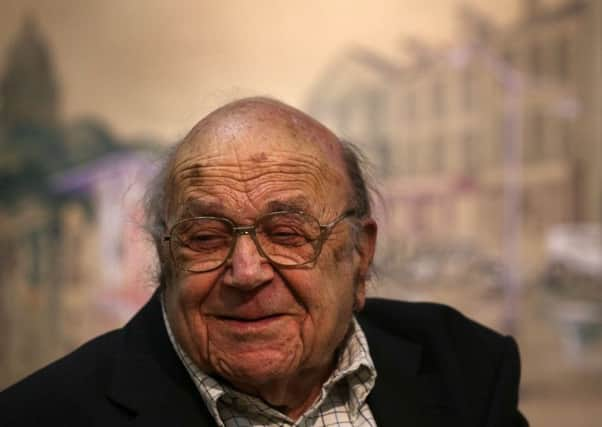Obituary: Antony Curtis Wolffe, MBE, architect and town planner


Antony Curtis Wolffe’s father was a lawyer. His mother, though herself a Lutheran Christian, came from a prominent Jewish family. He spent his early years in Berlin, attending school there and in the Black Forest. He was confirmed by the well-known anti-Nazi pastor, Martin Niemoller.
He spent the summer of 1934 in the UK and decided then and there that he would make this country his home. In due course he did, completing his schooling in England. He studied Architecture and Town Planning at Edinburgh College of Art from 1938 to 1944, interrupted by internment as an enemy alien on the Isle of Man and in Quebec.
Advertisement
Hide AdAdvertisement
Hide AdBetween 1944 and 1947, he worked for the Central and South East Scotland Regional Planning Advisory Committee. In 1947 he commenced practice as an architect in Edinburgh – among his commissions were alterations to the Outlook Tower (now the Camera Obscura). In the same year, he became a British citizen, and in 1950 changed his name from Kurt Wolfgang Schmidt to Antony Curtis Wolffe
In the late 1940s and early 1950s, he worked on planning strategies for the Isle of Lewis and the Burgh of Dumfries with Robert Hurd and Frank Mears. This work brought him to Galloway, where he lived first at Rockcliffe and then, from 1952, in Gatehouse-of-Fleet, which was to be his home for the rest of his life. He practised as an architect in Gatehouse (and, for a time, also in Dumfries) for 60 years before he retired in February 2012, between 1968 and 1982 in partnership with WAD Murphie.
During 65 years of practice, he was responsible for an immense body of work, most of it in Dumfries and Galloway. His particular interest and expertise in restoration and conservation was reflected in sensitive work on country houses, churches and farm and mill buildings throughout the region. Among commissions elsewhere, he worked in the 1970s on Callendar House, Falkirk.
For many years, he was a part-time inspector of historic buildings, and prepared the first statutory list of buildings of architectural and historical interest for Dumfries and Galloway.
He was Burgh Surveyor of Gatehouse-of-Fleet from 1956 to 1975. Between 1968 and 1985 he held a part-time lectureship in the Department of Town and Country Planning, Heriot-Watt University, commuting weekly between Gatehouse and Edinburgh, and between 1965 and 1992 he gave extra-mural lectures under the aegis of Glasgow University’s Department of Adult and Continuing Education. In 1975 he was awarded the MBE for services to architecture.
He gave liberally to others of his time, expertise and knowledge. At one time or another, he was convener of the Church of Scotland Committee on Artistic Matters, president of the Galloway Preservation Society and president of the Architectural Society of Scotland, an organisation which awarded him an Honorary Fellowship. He served as a Trustee of the Scottish Architectural Heritage Trust and was, for twenty years, an elder of Anwoth Parish. From 1981, he was a Trustee of the Murray Usher Foundation, a charity which promotes the betterment of Gatehouse-of-Fleet, including its citizens and visitors.
Before his retirement, the Royal Commission on Ancient and Historical Monuments in Scotland had decided that the archive of his professional practice should be preserved for the nation, and in 2015, RCAHMS put on an exhibition of his student drawings in Edinburgh (and subsequently in Gatehouse and Dumfries). At the opening of that exhibition, Edinburgh College of Art awarded him a medal which he would have received 70 years earlier if he had not been an enemy alien.
His interests were not confined to architecture. In the 1940s he canoed the seas around the Hebrides and on the west coast. He claimed, in his day, to have swum in every loch in Galloway. He was an accomplished cellist and, as a young man, sang with the Edinburgh Bach Choir. Pencil portraits which he made in the 1940s of the Nobel physicist Max Born, the literary scholar Sir Herbert Grierson and Robert Hurd (all of whom he knew well) are now in the collection of the Scottish National Portrait Gallery. During internment in Quebec, he taught himself wood-carving. He read widely on many subjects.
Advertisement
Hide AdAdvertisement
Hide AdHe never ceased to be grateful for the tolerance, sense of fairness and personal freedom he found in this country after Hitler’s Germany. He believed that Edinburgh was the most attractive city to live in. He loved Gatehouse-of-Fleet and its community of which he was part for so long. He believed strongly in the moral commitment which membership of a liberal profession entails. He retained his interest in music and the visual arts, and his intellectual curiosity, until he suffered a stroke, a week before his death.
He is survived by Alix, his wife of 55 years and four children.